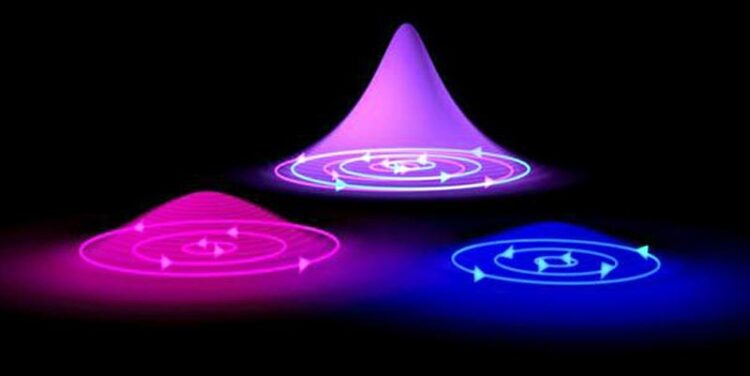Tiny quantum electronic vortexes

A new study by KTH Royal Institute of Technology and Stanford University revises of our understanding of quantum vortices in superconductors. Pictured, an artist’s depiction of quantum vortices. (Illustration: Greg Stewart, SLAC National Accelerator Laboratory)
Credit: Greg Stewart, SLAC National Accelerator Laboratory
… can circulate in superconductors in ways not seen before.
Within superconductors little tornadoes of electrons, known as quantum vortices, can occur which have important implications in superconducting applications such as quantum sensors. Now a new kind of superconducting vortex has been found, an international team of researchers reports.
Egor Babaev, professor at KTH Royal Institute of Technology in Stockholm, says the study revises the prevailing understanding of how electronic flow can occur in superconductors, based on work about quantum vortices that was recognized in the 2003 Nobel Prize award. The researchers at KTH, together with researchers from Stanford University, TD Lee Institute in Shanghai and AIST in Tsukuba, discovered that the magnetic flux produced by vortices in a superconductor can be divided up into a wider range of values than thought.
That represents a new insight into the fundamentals of superconductivity, and also potentially can be applied in superconducting electronics.
A vortex of magnetic flux happens when an external magnetic field is applied to a superconductor. The magnetic field penetrates the superconductor in the form of quantized magnetic flux tubes which form vortices. Babaev says that originally research held that quantum vortices pass through superconductors each carrying one quantum of magnetic flux. But arbitrary fractions of quantum flux were not a possibility entertained in earlier theories of superconductivity.
Using the Superconducting Quantum Interference Device (SQUID) at Stanford University Babaev’s co-authors, research scientist Yusuke Iguchi and Professor Kathryn A. Moler, showed at a microscopic level that quantum vortices can exist in a single electronic band. The team was able to create and move around these fractional quantum vortices, Moler says.
“Professor Babaev has been telling me for years that we could see something like this, but I didn’t believe it until Dr. Iguchi actually saw it and conducted a number of detailed checks,” she says.
The Stanford researchers found the initial observation of this phenomenon “so incredibly uncommon,” says Iguchi, that they repeated the experiment 75 times in at various locations and temperatures.
The work confirms a prediction Babaev published 20 years ago, which held that in certain kinds of crystals, one part of an electron population of a superconducting material can form a clockwise circulating vortex, while other electrons can form a counter-clockwise vortex simultaneously. “These combined quantum tornadoes can carry an arbitrary fraction of flux quantum,” he says.
“That revises of our understanding of quantum vortices in superconductors,” he says.
Moler affirmed that conclusion. “I have been looking at vortices in novel superconductors for over 25 years, and I have never seen this before,” she says.
Babaev says that the robustness of quantum vortices and the possibility to control them suggests that quantum vortices could potentially be used as information carriers in superconducting computers.
“The knowledge that we gain, the spectacular methods that were introduced by our colleagues Dr. Iguchi and Professor Moler at Stanford, may in a long run be potentially helpful for certain platforms for quantum computation,” Babaev says.
Journal: Science
DOI: 10.1126/science.abp9979
Method of Research: Observational study
Subject of Research: Not applicable
Article Title: Superconducting vortices carrying a temperature-dependent fraction of the flux quantum
Article Publication Date: 1-Jun-2023
All latest news from the category: Physics and Astronomy
This area deals with the fundamental laws and building blocks of nature and how they interact, the properties and the behavior of matter, and research into space and time and their structures.
innovations-report provides in-depth reports and articles on subjects such as astrophysics, laser technologies, nuclear, quantum, particle and solid-state physics, nanotechnologies, planetary research and findings (Mars, Venus) and developments related to the Hubble Telescope.
Newest articles

Why getting in touch with our ‘gerbil brain’ could help machines listen better
Macquarie University researchers have debunked a 75-year-old theory about how humans determine where sounds are coming from, and it could unlock the secret to creating a next generation of more…

Attosecond core-level spectroscopy reveals real-time molecular dynamics
Chemical reactions are complex mechanisms. Many different dynamical processes are involved, affecting both the electrons and the nucleus of the present atoms. Very often the strongly coupled electron and nuclear…

Free-forming organelles help plants adapt to climate change
Scientists uncover how plants “see” shades of light, temperature. Plants’ ability to sense light and temperature, and their ability to adapt to climate change, hinges on free-forming structures in their…





















